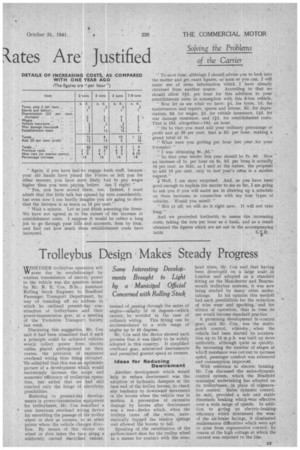Trolleybus Design Makes Steady Progress Some Interesting Developments Brought to Light by a Municipal Official Concerned with Rolling Stock
Page 21

If you've noticed an error in this article please click here to report it so we can fix it.
WHETHER trolleybus operation will 1fIr some day be revolutionized by wireless transmission of electric power to the vehicle was the question raised by Mr. R. E. Cox, B.Sc., Assistant Rolling Stock Engineer to Bradford Passenger Transport Department, by way of rounding off an address in which he outlined present-day construction of trolleybuses and their power-transmission gear, at a meeting of the Yorkshire Transport Society last week.
Discussing this suggestion, Mr. Cox said it had been visualized that if such a principle could be achieved vehicles would collect power from electric cables placed underground on their routes, the provision of expensive overhead wiring thus being obviated. 'He admitted that this was an optimistic picture of a development which would enormously increase the scope and economid efficiency of trolleybus operation, but added that we had still touched only the fringe of electricity possibilities.
Referring to present-day developments in power-transmission equipment for trolleybuses, Mr. Cox described a • new American overhead wiring device for smoothing the passage of the trolley wheel or shoe at corners, or at other points where the vehicle changes direction. By means of this device the wheel or shoe takes the turn alopg a uniformly curved electrified runner,
instead of ,,passing through the series of angles—usually bf 10 degrees—which cannot be avoided in the case of
ordinary wiring. This fitting can be accommodated to a wide range of angles up to 45 degrees.
Mr. Cox said the device showed such promise that it was -likely to be widely adopted in this country. It simplified overhead gear, minimized dowirements and permitted greater speed at corners.
Ideas for Reducing Dewirement Another development which would help to reduce dewirement was the adoption of hydraulic dampers at the base end of the trolley booms, to check any tendency to downward movement in the booms when the vehicle was in motion. A preventive of excessive damage by booms after dewirement was a new. device which, when the trolleys 'came off the wires, automatically tripped' the tension springs and allowed the 'booms to fall.
Speaking of the substitution of the carbon-insert shoe for the trolley wheel as a means for contact with the over,. head wires, Mr. Cox said :that having been developed on a large scale in London and adopted as a standard fitting on the Manchester and Bournemouth trolleybus systems, it was now being studied by many other under takings. In his opinion this methdd had such possibilities for the reduction of wire wear and sparking, and for silence of operation, that in time its use would become standard practice.
• A promising development in .control gear, said Mr. Cox, was the multi notch control, whereby, when the vehicle had been started its acceleration up to 15 m.p.h. was built up more
uniformly, although quite as quickly. By increasing the number of stages at which resistance was cut out to increase speed, passenger comfort was enhanced and consumption improved.
With reference to electric braking Mr. Cox discussed -the series-dynamic control system, which the Bradford municipal undertaking has adopted on its trolleybuses, in place of regenerative control. Series dynamic control,
.he said, provided a safe and stable rheostatic braking which "was effective over a wide range of speeds. In addition to giving an electric-braking
efficiency which minimized the wear of the air-brake facings, it eliminated maintenance difficulties which were apt to arise from regenerative control, by reason of the high voltage at which the current was returned to the line.




















































